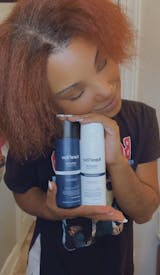At any one time, approximately 90 percent of you hair is growing, whilst the remaining 10 percent is in the resting phase.
On a two to three month cycle, the resting hair will fall out to make room for new hair which will grow in its place. One to five months after delivery, a process called Telogen effluvium occurs in just under 50 percent of women, resulting in the excessive shedding of hair. However, this increase in hair loss is only temporary and is nothing to worry about in the long term.
Why does Telogen effluvium occur?
During the pregnancy itself, the increase in the production of the oestrogen hormone acts to reduce the normal level of hair loss, which is why many women report a full and luxurious head of hair during pregnancy. Following the delivery, hormone levels return to normal and this extra hair soon falls out as you return to your usual hair growth cycle.
Although the hair loss itself takes place following delivery, it is during the pregnancy that the changes to the hair cycle occur. Throughout the pregnancy, an abnormal number of hairs enter the resting phase. After the delivery, once oestrogen levels have reduced, these resting hairs will fall out and you may start to notice a slight thinning of the hair. However, three to four months after the delivery your hair should start to thicken.
What other female health issues cause hair loss?
Hair loss in women is usually triggered by a change in the levels of oestrogen production, which can result from the following reproductive health issues:
- Discontinuing a course of birth control pills
- An abortion
- A miscarriage or still birth
Looking after your hair during and after pregnancy
There are a number of steps you can take to reduce your level of hair loss during and after a pregnancy:
- Avoid hairstyles such as braids, weaves, tight rollers and pigtails which can weaken, strain and pull the hair;
- Eat more fruit and vegetables to protect hair follicles and even promote growth;
- Avoid brushing, combing and styling wet hair which is weak and prone to breaking;
- Do not subject your hair to high temperatures. Reduce the temperature setting if you blow dry or straighten your hair;
- Take vitamin B, C and E, Zinc and Biotin supplements.
Are there any temporary solutions to cover up thinning hair?
There are the conventional options of wearing a hat, which is not always appropriate, or changing your hairstyle to one which is longer on the top to create the illusion of thicker hair.
There are also a range of hair fiber products which provide an excellent temporary solution to the problem. The majority of hair fiber products can be simply sprayed or shaken onto dry hair to provide additional volume and thickness.
Most quality hair fiber products are made from keratin, the protein which occurs naturally in hair, to give the look of real hair. The fibers themselves are electrically charged to create strong bonds with your natural hair. This ensures a secure hold which will last all day and withstand virtually anything Mother Nature will throw at!










